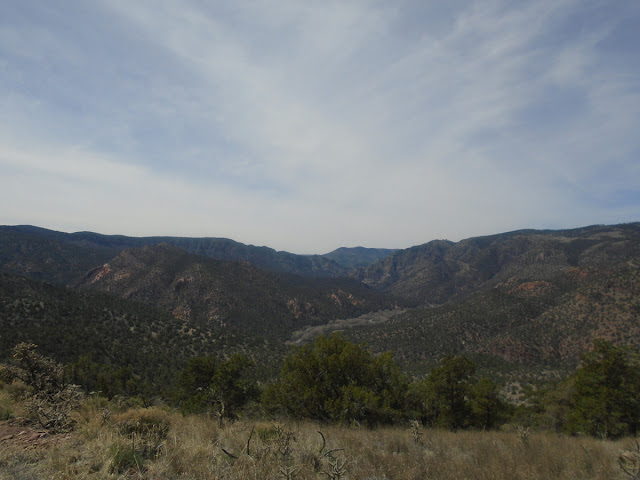After paying another visit to the
visitor centre – as usual I couldn't tear myself away from the book
section – we, too, headed into the (somewhat) lower area to enjoy
some easy living: we had booked a spot at the Gila Hot Springs
Campground for the night, a privately owned, small campground right
by the Gila river. Carla, the owner, welcomed us and sent us to our
camping spot, nicely treed, with soft sand as a very nice base for
our tent. For US $8 per person we could not only put up our tent for
the night but also soak in one of three hot pools as long as we
wanted or could stand it. This would come in very handy tonight since
it was supposed to get cold, likely below freezing.
We took advantage of this when the sun
was about to slip below the rocky walls in the west and it started to
get cooler. Allen, Carla's husband, like her looking to be in his
seventies, paid us a visit and told us that these three hot springs
were in fact hot pools they built, fed by hot water they piped down
from the hills behind us. The water is about 65 degrees Celsius where
it comes out of the ground, but by the time it reaches the pools it
is 59 or 60 degrees.
For us it was perfect, and while there
were a few other campers – not many: the campground has only twelve
camping spots, and some of them were empty – nobody felt inclined
to use the pools just then, so we were all by ourselves. Slowly the
stars came out, first only here and there, but by the time we were
ready to leave the pool the whole sky was ablaze with light. Rarely
have I seen so many stars! The bright stars in Orion and Sirius
seemed to be surrounded by halos and huge, much brighter than they
normally seem to be. Although it was quite cool by now we were
totally warmed through, and, armed with wool socks and a layer more
than I usually wear in my cozy sleeping bag I wasn't cold at all that
night.
 |
| Johann's bathing trunks frozen stiff after 'drying' draped over the pickup box overnight |
The next morning was a different story.
In this narrow valley it would take a good long while for the sun to
find its way here. The hot pools were waiting, but to leave the
warmth of the sleeping bag to walk the fifty metres or so and then
put on a cold bathing suit took some determination. Still, we
couldn't stay in the tent forever, and the hot water was beckoning,
so once the thin sliver of moon had cleared the canyon wall in the
east the sun had at least to be thinking of making its appearance,
and the intervening time would best be spent in the hot water, we
decided.
 |
| Dragon water spout for drinking water (hot as well) |
By the time the moon had faded and the
sun sent its first warming rays onto our picnic bench we were packed
and ready to go.
We had not too long of a drive ahead, so we decided
to follow the recommendation of the ranger and seek out S.A. canyon,
accessible from the Grapevine trailhead a bit further down the Gila
river, not far from where we had camped. 'It's a neat place to walk,'
she had told us, ' a narrow canyon where you can find crystals.'
It was indeed a nice walk, maybe a
kilometre along the rocky canyon bottom where, as promised, we soon
saw sparks of light reflected from the rocks with their crystal
inlays. A tiny creek appeared seemingly out of nowhere, and we
crossed it back and forth following it up to a deeper pool fed by a
little waterfall. This was where the hike ended for us: there was no
foothold anymore, and the water was too cold to consider wading through up to
our thighs. We sat near some blooming wild gooseberry bushes for a
bit, teeming with bumblebees happy for the first source of food of
the season. A bit further down I found a blooming maple – spring is
definitely in the air along the Gila river.
Johann's hope to find a trailhead to
hike for a bit along the Continental Divide Trail on our way along Hwy 35 towards our next destination was not fulfilled;
while we crossed the divide we could find no marked trail. What we
did find, a while later, was the Emory Pass at the top of another winding climb along a very scenic route. At nearly 2,500m the viewpoint just
above the pass provides a great view of the area to the north.
We found a motel room on the outskirts
of a place with a very strange name: Truth or Consequences, short T
or C, originally named Hot Springs because of the artesian wells with
heavily mineralized water that flow freely in several places in this
town.






















































